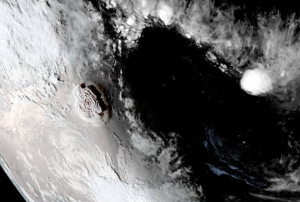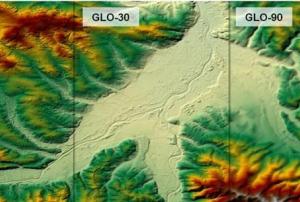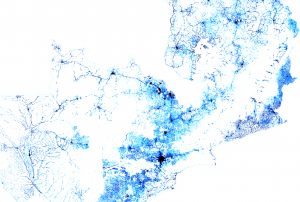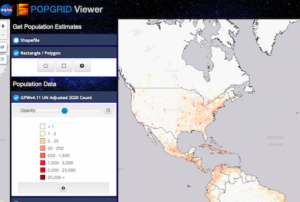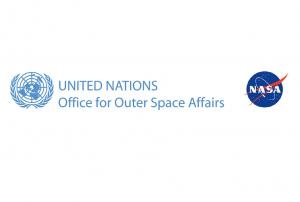Tsunami
Definition
Facts and figures
Further information
UN-SPIDER Regional Support Offices with hazard-specific expertise
Related content on the Knowledge Portal
Matthew Blackett, Coventry University
The scale of a recent volcano eruption took the people of Tonga by surprise. Scientists monitoring the submarine volcano, Hunga Tonga-Hunga Ha'apai, were likewise caught off-guard, failing to foresee an explosion which would unleash a Pacific-wide tsunami.
The scale of the eruption was hailed as a “once in a millenium” event by one scientist. It hurled gasses and ash over 39km into the atmosphere – comparable to that ejected from Mount Pinatubo in 1991 – and generated a...
read more28/01/2022On the 13th and 15th of January 2022 the underwater volcano on Hunga Tonga-Hunga Ha’pai, located in the South Pacific Kingdom of Tonga erupted. The eruption on the 15th of January 2022 was seven times more powerful than the first eruption of the volcano, which took place on the 20th of December 2021. Additionally, it led to a tidal gauge, resulting in a tsunami wave that impacted countries in the Pacific Ocean, from the Kingdom of Tonga, Australia and New Zealand, Japan, up to Peru, among others, on the other side of the Pacific.
The volcanic eruption was captured by the GOES-West Earth-observing satellite operated by the U.S. National Oceanic and Atmospheric Administration (NOAA), as well as by the Himawari-8 satellite, operated by the Japan Meteorological Agency (JMA), resulting in spectacular images, revealing the large extent of this event.
This is an example of the capacity of geostationary satellites and the benefit of meteorological satellites tracking large...
read more18/01/2021- The Copernicus DEM is a Digital Surface Model (DSM) which represents the surface of the Earth including buildings, infrastructure, and vegetation. The Copernicus DEM is provided in 3 different instances. Two worldwide coverages at 90m (GLO-90) and 30m (GLO-30) resolution are openly available to the public for download via the PANDA Catalogue and FTP. A further European coverage (EEA-10) is provided at 10m resolution, but data is restricted to eligible users who meet required access rights.Publishing institution:
- The Copernicus DEM is a Digital Surface Model (DSM) which represents the surface of the Earth including buildings, infrastructure, and vegetation. The Copernicus DEM is provided in 3 different instances. Two worldwide coverages at 90m (GLO-90) and 30m (GLO-30) resolution are openly available to the public for download via the PANDA Catalogue and FTP. A further European coverage (EEA-10) is provided at 10m resolution, but data is restricted to eligible users who meet required access rights.Publishing institution:
- Publishing institution:
- Publishing institution:
- Facebook Connectivity Lab in collaboration with the Center for International Earth Science Information Network (CIESIN) at Colombia University combines machine vision AI with satellite imagery and census information to create population density maps. With the integration of demographic information, specifically related to age and gender, these maps collectively provide information on both the location and the demographic of a population in a certain country. The population density maps cover the majority of countries around the world.Publishing institution:
- Facebook Connectivity Lab in collaboration with the Center for International Earth Science Information Network (CIESIN) at Colombia University combines machine vision AI with satellite imagery and census information to create population density maps. With the integration of demographic information, specifically related to age and gender, these maps collectively provide information on both the location and the demographic of a population in a certain country. The population density maps cover the majority of countries around the world.Publishing institution:
Having reliable and timely population distribution data can make a life or death difference for individuals facing crises or living in conflict-ridden regions. These data are also essential for development decision-making and planning and for monitoring progress towards the UN Sustainable Development Goals (SDGs) established by the international community. We need to know where people are located, what conditions they are facing, what infrastructure is available, and what basic services they can access. We also need to ensure that no one is left off the map in pursuit of meeting the SDGs.
Gridded population data, which often use remote sensing inputs to improve the spatial allocation of population within a country, are vital for all these purposes. Together with the growing variety of applications that require spatial population data, there is now a bewildering array of population grids, and users need to know which ones are most suitable for their applications...
read moreThe United Nations Office for Outer Space Affairs (UNOOSA) and the National Aeronautics and Space Administration of the United States Government (NASA) signed a landmark Memorandum of Understanding (MoU) on 17 December 2020 pledging cooperation in areas of science and technology to support the peaceful uses of outer space.
The MoU brings together NASA's wealth of open-source spacecraft data, tools, and expertise and UNOOSA's unique position as the only UN entity dedicated to outer space affairs, to expand global opportunities to leverage the benefits of space. The partners will design capacity-building programmes, particularly for institutions in countries that do not yet have or that are developing space capabilities, to help them access space.
Together, UNOOSA and NASA will develop ways to leverage the Artemis programme as part of UNOOSA's Access to Space 4 All Initiative, which offers opportunities for international researchers and institutions, especially in...
read more11/01/2021

